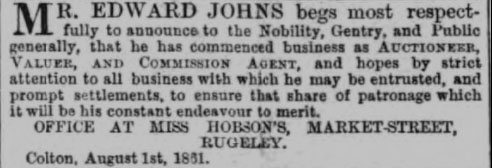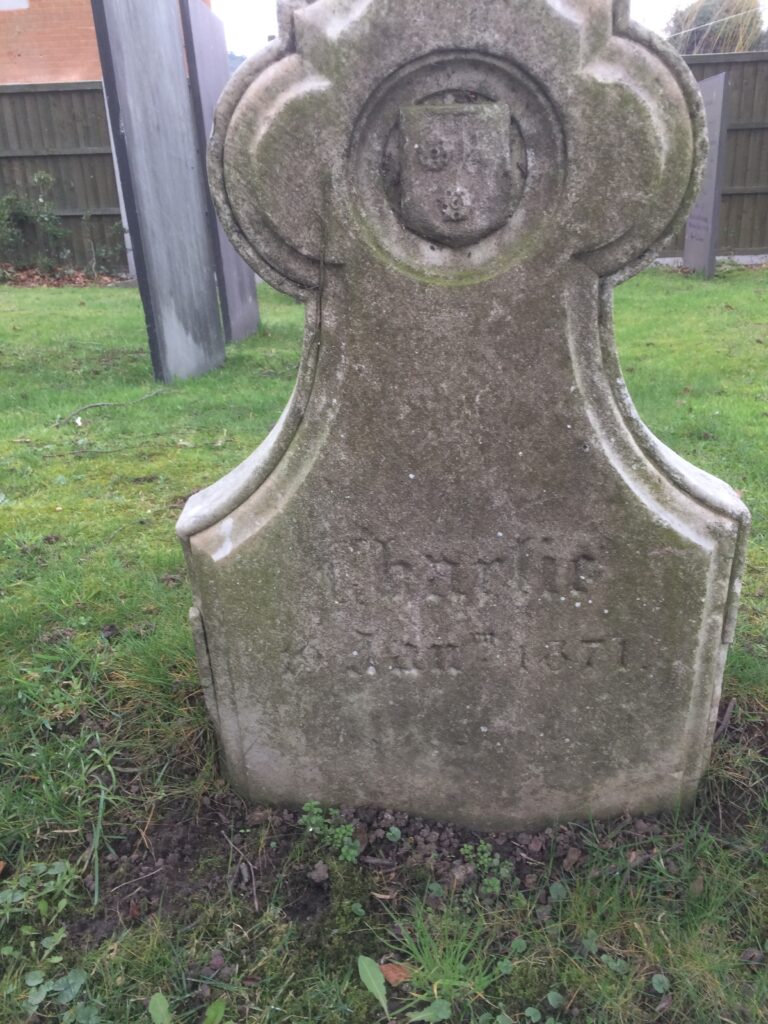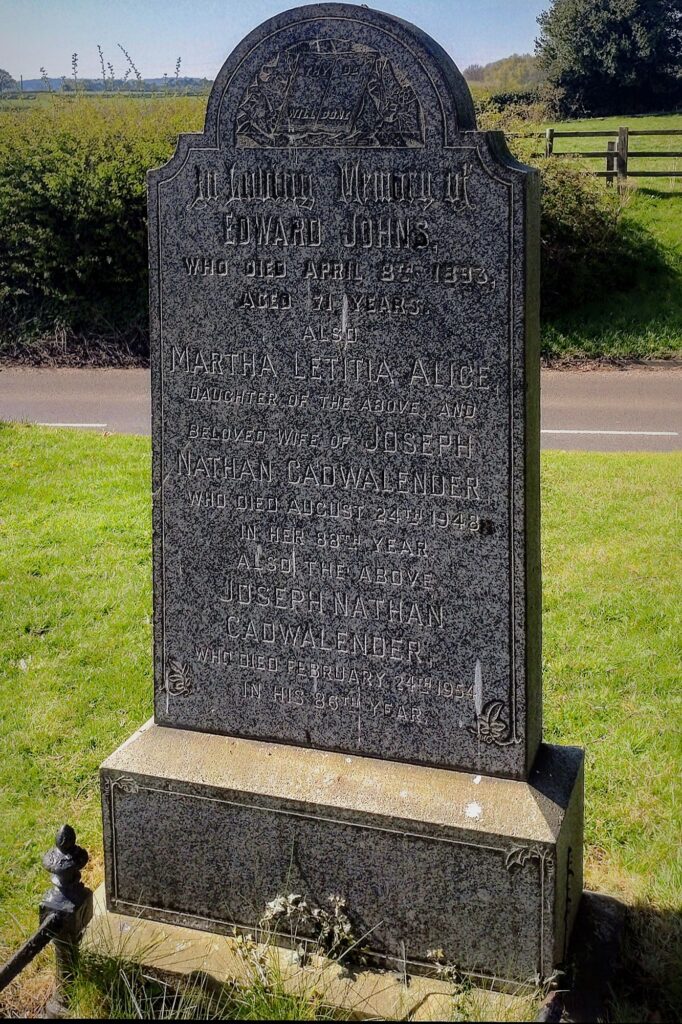
By the time of his death in 1893 Edward Johns had created Edward Johns & Co., a major exporter in the pottery industry (later Armitage Ware, Armitage Shanks and now part of Ideal Standard) and put the village of Armitage well and truly on the map.
But he started out his working life as a draper’s apprentice so what sort of person was he and how did he do it? Well, at the age of 18 he was still living at home working as his father’s apprentice in Bristol. Not far away though was the New Room, the oldest purpose-built Methodist meeting house – built in fact by John Wesley, their most prominent founder. Methodism had originated as a revivalist movement within the Church of England and focussed on sanctification and the effect of faith on the character of a Christian. It had a direct, passionate style with plenty of damnation and potential salvation. Some of them became known as ‘the ranters’ for their loud singing in the streets. Perfect for Edward who became the Reverend Edward Johns and an itinerant Minister striding about the country with his rather plain, black clothing.
By the late 1840’s he was in Staffordshire and conducting services – often in the open air – and weddings. As well as being evangelical – we would now probably class it as fundamentalist – he would have emphasised charity and support for the sick and needy. Sermons concentrated on saints and sinners, fire and brimstone. He became Minister at the Mount Zion Chapel in Great Haywood which had been erected in 1845. One of the founders and the main benefactor for the new chapel had been Thomas Devall who died before it was completed. Another founder was James Whittle who had married Thomas’ sister, Martha. James, who owned houses and railway shares, possibly inherited from Martha’s first husband, John Mottershaw, died in January 1849. Martha was about double Edward’s age and had now been widowed twice. Nevertheless, in June 1850, they were married at the Chapel and they lived in her house in Great Haywood.
Martha died in 1856 and Edward inherited houses and railway shares and was suddenly able to call himself a ‘gentleman’ i.e. wealthy enough to not have to work. Just eighteen months later he married Martha Williamson in Birmingham, a spinster with a two-year-old son, and a very short time after that his own son, Edward Lewis Williamson Johns, was born in Longdon.
Edward and his young family moved to Colton and Edward became a man of leisure. He soon showed that he had the skill which we would now call networking when he became a founder member of the Rugeley Rangers – the 21st Staffordshire Volunteer Corps, many of whom were in the higher reaches of local society. (Not too many years later their fellow Corps in the County derided them with the term ‘The Poisoners’ after William Palmer). The Captain of the Corps was Josiah Spode IV of Armitage Park and he quickly promoted Edward to Sergeant. At the inaugural shooting competition held at Etching Hill Edward won the Champions Cup – clearly not a man to be trifled with. With the beginnings of his network he decided to build on it with his passion and oratorical skills and became an auctioneer.

Edward sold all sorts of items as an auctioneer – houses, furniture, farm equipment, timber and so on – all over the local area, some of the time from public houses and some just standing in a field next to the hayrick he was selling. He was used to cajoling people at open air gatherings and you can just imagine his auctioneer patter as he pushed the price as high as he possibly could. Over the next few years his business prospered and two daughters, Martha Letitia Alice and Elizabeth Ann, joined his happy family. And then his wife died, early in 1864, not long after his third child was born.
The last advertisement that can be found for one of his auctions appears in the Staffordshire Advertiser on 12th December 1863. It was for four houses owned by John Lloyd Mountford and they were to be sold by Edward at the Crown Inn in Handsacre on 23rd December. Mountford was one of the people running the Old Pottery at Armitage and no doubt there was some discussion about the pottery which had been struggling for some time. In fact, the pottery had been out of action on and off since it was rebuilt by Thomas Bond in 1817.
There are no records giving the date at which Edward began managing the Old Pottery but when he became a Freemason at Bradford, Yorkshire on 16 June 1864 his address was given as Armitage, Staffordshire and his occupation as earthenware manufacturer. (Why he went to Bradford in Yorkshire to become a Freemason is a complete mystery). In 1852 a second pottery had been built in the village, the New Pottery obviously, but that too had struggled and had closed down in 1861 and it was put up for sale or lease (again) in 1866. In the next twelve months:-
- Edward Johns married Eleanor Haynes in Manchester
- Josiah Spode IV bought the ‘New Pottery’
- Edward Johns bought the ‘Old Pottery’ for £1,000 on 20th March 1867. A mortgage for £1,000 with Josiah Spode IV was completed five days later.
- Josiah Spode put out a tender to dismantle the ‘New Pottery’ in June 1867 and it was duly dismantled.
No competition for raw materials, labour, skills – Edward had added ruthlessness to his skill set!
The advert for the sale of the New Pottery had stated that the Old Pottery next door made sanitary ware. It had started out making general tableware and some sanitary ware had been introduced in the early- to mid-1850s. There was now a greater interest in sanitation and for systems that supplied water at pressure to houses. Edward had spotted a niche and his company concentrated exclusively on the sanitary ware market. The products being made at that time were very crude with flushing systems often just being a trickle of water and someone needed to invent brand new ideas and products. This was very definitely not one of his talents and neither were any of his employees capable of it. Edward used his networking skills and went out and found people with the right skills. People like Daniel Bostel of Brighton who invented the first wash out water closet in the world. Bostel could design it but he wasn’t a potter so between him and Edward’s mould makers they made a product which won awards. In fact the company proudly boasts that their Dolphin water closet was exhibited at the Centenary Philadelphia Exhibition in 1876 and led to a boom in sales to the USA.

Edward maintained his interest in Methodism and was a big supporter of the Congregational Church in Armitage. A typical holiday or chapel anniversary tea would find him presiding over gatherings of 200 or more. It wasn’t just the Congregationalists though – he laid the foundation stone for the Primitive Methodist Chapel at Handsacre in 1872.
So what sort of person was he? Edward made his mark by spotting an opening and exploiting it ruthlessly, by being a charismatic person who attracted attention and friendship. He was passionate about his religion but also overpowering – when his dog Charlie died in 1871 he ‘persuaded’ them to let the dog be buried in the Chapel graveyard. If you walk towards the Chapel and turn to your right you will see Charlie’s gravestone.



Hello Edward is my great uncle . Is there a Museum…or any collections I could look at .
The Gladstone Pottery Museum in Stoke-on-Trent, https://www.stokemuseums.org.uk/gpm/, covers the history of the area and has some Armitage material.
G’day Richard,
Elizabeth “Annie” Johns married Dr Leonard Redmond and settled in Charters Towers, Queensland. Their second son Edward “Vernon” Redmond, a Government Engineer with fame (conceived and built a successful levee around Goondiwindi), had a granddaughter Lyn who shares my life near Melbourne.
I have read your story of Edward (nice job).
Lyn is delighted to hear about Charlie.
I can update you about the Australian generations, but I doubt you want it all and it doesn’t relate to Staffordshire.
I should be interested to know more (I have family history as a retirement hobby/affliction).
I have some family background on Edward if you would like it and you could also read about his pottery in my book which is available from the Ridware History Society https://ridwarehistorysociety.com/publications/